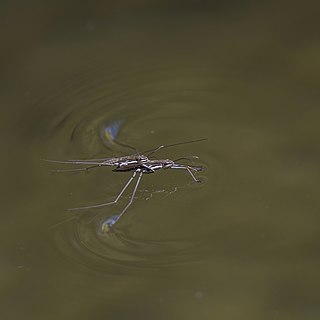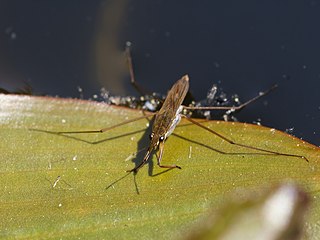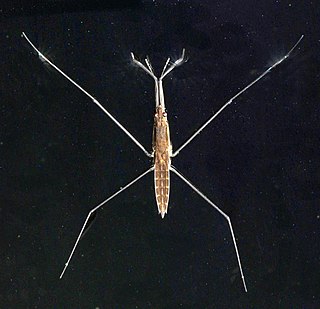
The Gerridae are a family of insects in the order Hemiptera, commonly known as water striders, water skeeters, water scooters, water bugs, pond skaters, water skippers, water gliders, water skimmers or puddle flies. Consistent with the classification of the Gerridae as true bugs, gerrids have mouthparts evolved for piercing and sucking, and distinguish themselves by having the unusual ability to walk on water, making them pleuston (surface-living) animals. They are anatomically built to transfer their weight to be able to run on top of the water's surface. As a result, one could likely find water striders present in any pond, river, or lake. Over 1,700 species of gerrids have been described, 10% of them being marine.

Water treaders, the superfamily Mesovelioidea, are insects in the order Hemiptera, the true bugs. They are semiaquatic insects that live in moist and wet habitat and on wet plant matter in several types of aquatic habitat.

Gerrinae is a subfamily of water strider. This subfamily includes the largest and most best-known group of Gerridae. They are also a phylogenetic subfamily made up of two tribes, and ~14 genera.
Tachygerrini is a tribe of water striders containing 21 species in 2 genera. In addition to the two extant genera, Eurygerris and Tachygerris, Andersen included the extinct genus Eurygerris within the Tachygerrini.

Gerris is a bug genus in the family Gerridae.

Laccotrephes is a genus of water scorpion belonging to the family Nepidae. They are carnivorous insects that hunt near the water surface. They are not aggressive, but may inflict a painful bite if not handled carefully, which may cause a local reaction. There are about 60 species found in shallow stagnant or slow-moving waters in warm parts of Africa, Asia and Australia.

Aquarius is a genus of water striders found predominantly in the northern hemisphere. Formerly a subgenus, Aquarius was elevated to generic rank in 1990 on the basis of phylogenetic analysis. These are among the world's largest water striders, with females averaging 12–17 mm (0.47–0.67 in) long and males roughly 10–30% smaller, depending on the exact species. An outlier is A. elongatus where both sexes typically are about 24 mm (0.94 in), roughly the same as certain Cylindrostethus, and second only to Gigantometra gigas.
Rhagovelia choreutes is a species in the infraorder Gerromorpha, in the order Hemiptera . The distribution range of Rhagovelia choreutes includes Central America and North America.

Rhagovelia obesa is a species of smaller water striders in the family Veliidae. It is found in North America.

Mesovelia is a genus of water treaders in the family Mesoveliidae. There are more than 30 described species in Mesovelia.

Mesoveliidae is a family of water treaders in the order Hemiptera. There are about 16 genera and at least 50 described species in Mesoveliidae.

Limnogonus is a genus of water striders in the family Gerridae. There are 28 described species in Limnogonus. Similar to other gerromorphan bugs, most species of Limnogonus have both macropterous specimens, which means that they are often able to fly. The wings are thought to be an adaptation to help the insects get away from drought allowing them to fly to the next available area that has water bodies when the rainy season arrives

Hermatobates is a genus of wingless marine bugs placed as the sole genus in the family Hermatobatidae that are sometimes known as coral-treaders. They are quite rare and known only from coral reefs in the Indo-Pacific region. During low tide, they move over the water surface not unlike the more familiar water-striders around coral atolls and reefs and stay submerged in reef crevices during high tide.

Limnometra is a genus of water striders in the family Gerridae. There are more than 30 described species in Limnometra found in Indomalaya and Oceania.












